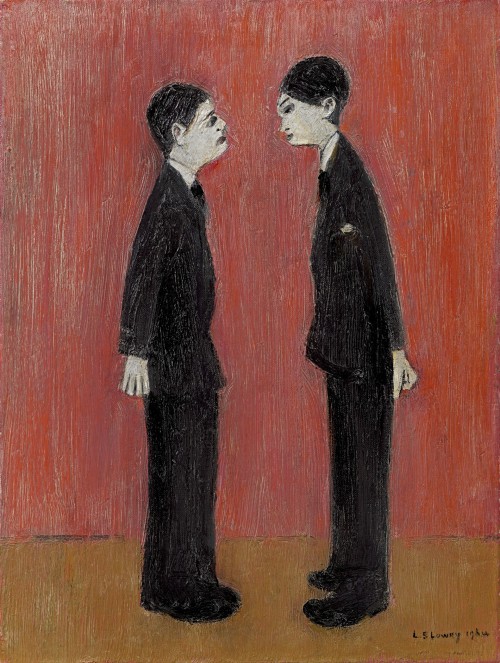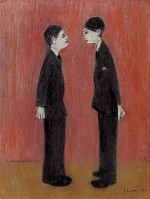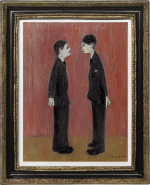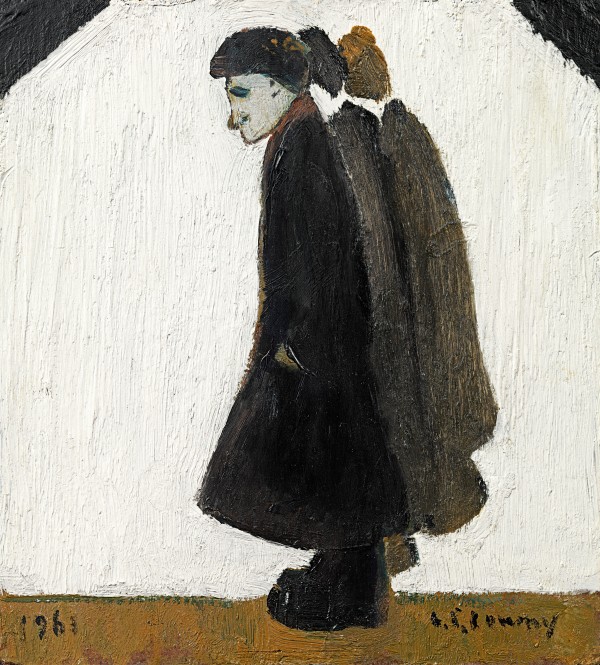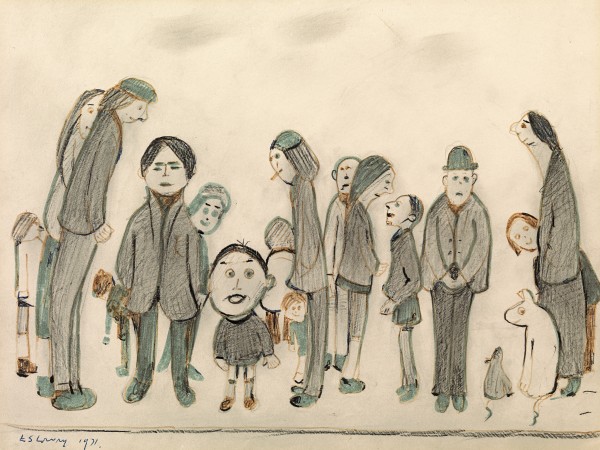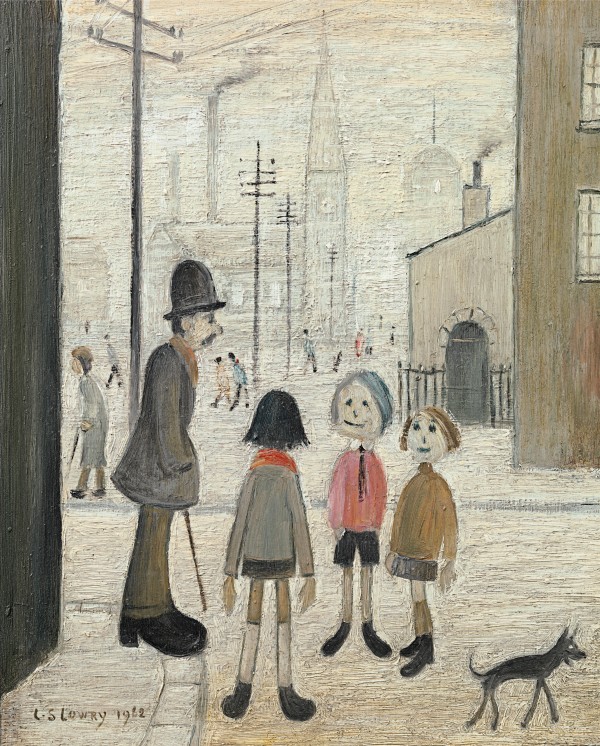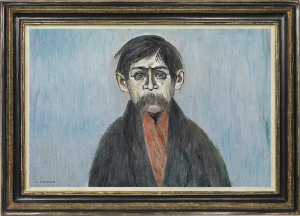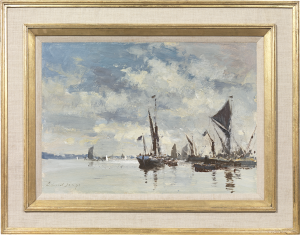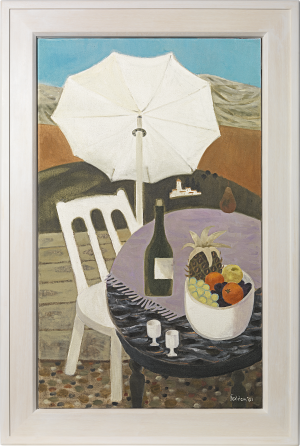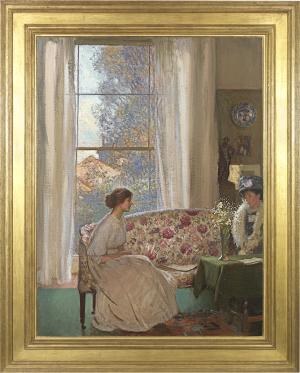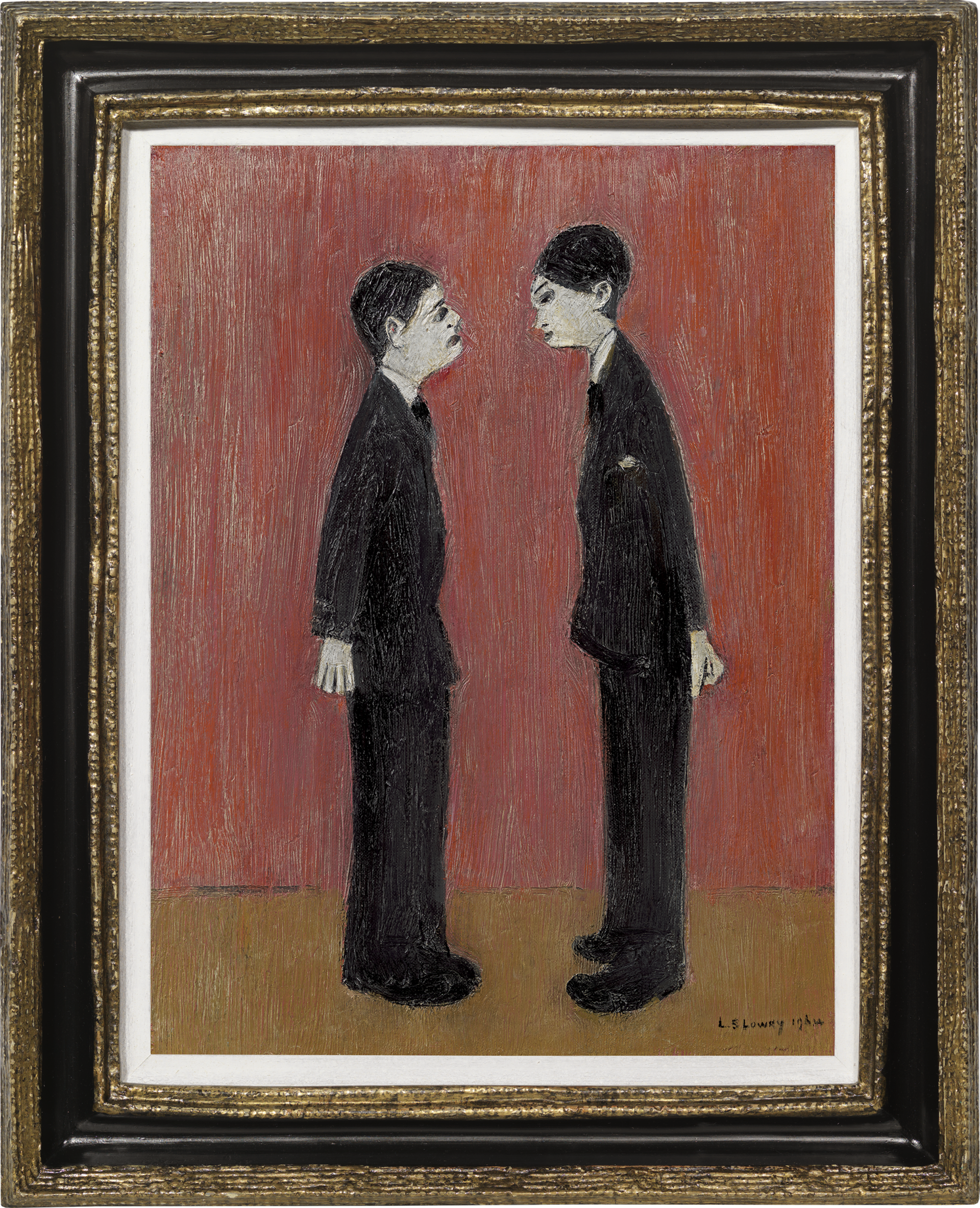Laurence Stephen Lowry
Two men talking
Oil on canvas: 16 x 12 (in) / 40.6 x 30.5 (cm)
Signed and dated lower right: LS LOWRY 1964; inscribed on the overlap: TWO MEN TALKING
This artwork is for sale.
Please contact us on: +44 (0)20 7493 3939.
Email us
LAURENCE STEPHEN LOWRY RA RBA LG NS
Manchester 1887 - 1976 Glossop
Ref: CC 125
Two men talking
Signed and dated lower right: L.S LOWRY 1964; inscribed on the overlap: TWO MEN TALKING
Oil on canvas: 16 x 12 in / 40.6 x 30.5 cm
Frame size: 20 ½ x 16 ½ in / 52.1 x 41.9 cm
7
Provenance:
Lefevre Gallery, London, directly from the artist [X8302];
private collection, acquired from the above, January 1975
Christie’s London, 25th November 2015, lot 31;
Richard Green, London, 2015;
private collection, UK
Lowry painted two works entitled Two men talking, the first in 1941 and the second twenty-three years later. At roughly the same size, both upright works feature two standing figures dressed in dark suits facing each other in an interior. The changes Lowry made more than two decades later to the figures and their setting, transform the impact of this rare and powerful painting. In the present work the two men glare at each other, their chalk white faces expressing anger and frustration echoed by the placement of their hands (previously in their pockets), the figure on the right forming a fist. In contrast to the relaxed, conversational atmosphere of the earlier painting, the figures confront each other face-to-face, their rigid poses filled with tension, repeated in the emotive background. While the light setting of the earlier work contained details of an office interior; a bookshelf, desk, door and dado rail, in the present work only the ground is defined against a striking red screen, accentuating the heated tone and intensity of the psychological exchange. The backdrop is far from flat however, its colour ranging from ochre to vermillion with white striations applied in bold, vertical strokes, its vivid fluctuation adding further drama.
Mervyn Levy suggests that many of Lowry’s figural groups are ‘studies in the problem of communication. Lowry was haunted by this idea, and once told the writer that he did not believe that, in the end, any human being could really make contact with another. His own sense of isolation led him to show his characters’ isolation even when they are apparently taking part in some joint activity. Frequently they are set in situations, and settings, which serve to emphasize this isolation.’[1]
Lowry enjoyed painting the interaction between pairs of figures during the 1960s, in works including My two uncles, 1962 (Laing Art Gallery, Newcastle), Two people, 1963 (The Lowry, Salford), and Two figures, 1961 (Kirklees Museums and Galleries), remarking of his later character studies, ‘I think this is my best period… I think I am saying more, going deeper into life than I did.’[2]
LAURENCE STEPHEN LOWRY RA RBA LG NS
Manchester 1887 - 1976 Glossop
Sir Hugh Casson, in his preface to the 1976 Royal Academy Memorial exhibition, referred to LS Lowry as ‘one of the great English painters of this century.’ An individual artist with a unique style, Lowry’s work spans the first half of the twentieth century, recording with sensitivity and wit his own personal view of the people and architecture of the industrial north.
Born in Manchester in 1887, Laurence Stephen Lowry was the only child of Robert and Elizabeth Lowry. He started drawing at the age of eight and in 1903 began private painting classes which marked the start of a part-time education in art that was to continue for twenty years. In 1904, aged 16, he left school and secured a job as a clerk in a chartered accountants’ firm; he remained in full-time employment until his retirement at the age of 65. His desire to be considered a serious artist led him to keep his professional and artistic life completely separate and it was not disclosed until after his death that he had worked for most of his life.
Lowry’s early training was at the Municipal College of Art, Manchester. There he was taught by the French artist Adolphe Valette who introduced him to Impressionism and of whom he said: ‘I owe so much to him for it was he who first showed me good drawings by the great masters…he gave me the feeling that life drawing was a very wonderful thing.’ Lowry was, however, unaffected by Valette’s impressionist technique and continued to develop a more realistic approach to his art.
In 1909 Lowry and his parents moved to Pendlebury, where initially he was not happy, and for some years ignored his surroundings. In 1916, whilst waiting for a train, he became fascinated by the workers leaving the Acme Spinning Company Mill; the combination of the people and the surroundings was a revelation to him and marked the turning point in his artistic career. He now began to explore the industrial areas of South Lancashire and discovered a wealth of inspiration, remarking ‘My subjects were all around me…in those days there were mills and collieries all around Pendlebury. The people who work there were passing morning and night. All my material was on my doorstep.’
By 1920 Lowry’s street scenes, peopled with workers, housewives and children set against a backdrop of industrial buildings and terraced houses, had become central to his highly personal style. From now on he painted entirely from experience and believed that you should ‘paint the place you know.’ His leisure time was spent walking the streets of Manchester and Salford making pencil sketches on scraps of paper and the backs of used envelopes, recording anything that could be used in his work. In his early factory scenes the emphasis is placed on the buildings and the atmosphere was often dark and sombre; however, as he developed this theme the figures became more prominent and eventually he arrived at a marriage between the two where the figures and surroundings form a whole.
By the 1930s Lowry had established his own particular style. He was encouraged by his teacher Bernard Taylor to try to make his figures and buildings stand out more and he began to experiment with setting them against a white background. He chose ‘flake white,’ building up layer after layer on the canvas before painting the subject matter straight on top. He used only four other colours: vermilion, Prussian blue, ivory black and ochre, which he applied straight from the tube.
With the onset of the modernisation of the industrial north in the mid-1950s Lowry lost interest in his surroundings and now concentrated almost entirely on figures silhouetted against a white background, occasionally standing on a hint of a pavement or near a ghost of a wall, but frequently suspended in time and space. He continued to sketch and closely observe his subjects and his works from this period capture the essence of Northern people; he frequently mixes young and old and he imparts to each figure an individual character. Shelley Rohde in A Private View of LS Lowry comments: ‘he had a new obsession, his single figures, his grotesques. The struggling, surging, misshapen homunculi who used to live for so long in the shadow of the mills emerging at last from their background to stand alone, as he stood alone’.
Visits to Wales in the 1960s with his friend and patron Monty Bloom briefly revived Lowry’s interest in industrial scenes. He was impressed by the contrast between the industrial towns and the surrounding countryside; consequently his paintings from this period are brighter than his Lancashire paintings. However, towards the end of the 1960s Lowry began to lose his creative urge and, with the exception of the occasional moment of artistic inspiration, he ceased painting almost entirely.
Laurence Stephen Lowry died of pneumonia in 1976, aged 88. Although he had received critical acclaim for his work during the second half of his life, he never forgot the lack of recognition that he had received initially and he carried with him the feeling of isolation and rejection throughout his career. He refused the offer of a knighthood, as well as numerous other honours, and remained disillusioned with the art world despite the praise that was heaped upon him.
Lowry is remembered as a man of remarkable resilience and sensitivity; he stood alone, unaffected by the influences of other artists and his inspiration came entirely from his own experience. His paintings and drawings are now included in most important private and public collections in the United Kingdom and abroad and his unique works continue to receive the critical acclaim that he so richly deserves.
[1] Mervyn Levy, The Drawings of LS Lowry Public and Private, Jupiter Books, London 1976, no.230.
[2] The artist cited in Michael Howard, Lowry: A Visionary Artist, Lowry Press, Salford 2000, p.201.

